One of Mangalore’s traditional dishes that I believe is almost on the verge of extinction is this delicious masterpiece, a curry made of horse gram and field marrow. Field marrow, also known as the Mangalore/Malabar cucumber is native of coastal Karnataka and Kerala and hence found as a regular item on the menu of these local cuisines. In Mangalorean cuisine there are plenty of preparations that call for the field marrow but not as many with horsegram. At least not that I ever knew of. Not until I found this recipe in the Mangalore Ladies Club Cookery Book. I believe that every community in Mangalore (ex, the Catholic, Konkani, Bunt, Brahmin etc) have their own mild variations of this curry and since I had never eaten it before, I have adapted this recipe to create my own family favourite.
Today I am reposting my old recipe which I had published in March 2010. I feel that this lovely curry has been lost somewhere in my archives and deserves to be dug out and put on a pedestal.
It is one of the recipes that talks volumes about the simple middle class life of Mangalore a few decades ago. From what I have gathered, a few decades ago horse gram or kulith as we call it in Konkani was only used as cattle feed and the cream of the society didn’t eat it or maybe not as much as the people from the lower strata of society. Pretty much as wholemeal which was considered to be food of those who couldn’t afford to buy the deceptively ‘clean’ and whitened flour (maida). Over the years however, this thinking has changed and people have come to recognize the health benefits of this humble legume.
In the olden days most vegetables that have a long shelf life were harvested and stored carefully before the monsoons began. Veggies such as pumpkins, ash gourd (winter melons), bottle gourds and field marrows were tied with jute strings and hung from the ceiling in the corridors that connected the kitchen to the dining area of traditional Mangalorean homes. This was such a wonderful sight that people still fondly remember them and try to replicate this scene during the ‘Roce’ function (pre-wedding ceremony) in Mangalore. A simple ‘kulta-kaat’ served with steaming hot red boiled rice and perhaps a papad and pickle completed a weekday meal.
I really hope you try this recipe and enjoy the pleasures of eating a simple Mangalorean meal 🙂
This picture of my first attempt at making the Kulta Kaat was posted in May 2010
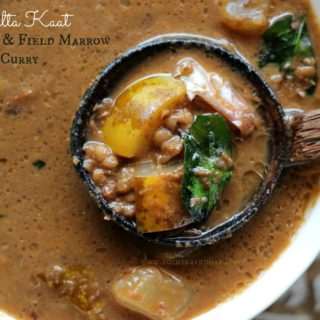
Kulta Kaat (Traditional Mangalorean Horse Gram & Field Marrow Curry)
Horsegram and field marrow come together in this traditional Mangalorean spicy-sweet-tangy curry that pairs very well with rice or chapathis.
Print
Pin
Rate
Ingredients
- 1 cup horsegram kulith/kulath
- 1 small field marrow/ Mangalore cucumber/ mogem/magge/sauthe kai
- 4 cups water
- 2-3 teaspoons powdered jaggery adjust to taste
- salt to taste
- For the masala:
- 4 long dry red chillies Byadge/Bedgi variety * see notes
- 5 peppercorns
- 3/4 th teaspoon mustard
- 4-5 garlic flakes
- 2 teaspoons grated coconut optional
- 1 marble size ball of tamarind
- For tempering:
- 1 sprig curry leaves
- 3 garlic flakes with skin lightly bruised
- 1-2 tablespoons ghee or oil preferably coconut
Instructions
- Wash and cut the field marrow in quarters. Scrape off the pith and seeds (‘girope’ in Konkani) and cut into medium sized cubes. Keep aside.
- Heat a skillet/tawa and dry roast the horsegram for a few minutes on a low heat till you get a nice aroma. Take care not to burn it. Remove, allow to cool and then coarsely pound till they are broken lightly. This is an optional step.
- Transfer the horsegram into a pressure cooker. Add 4 cups of water and salt to taste and pressure cook for about 5-6 whistles. Remove from heat and let the cooker cool down. Open and check if it is tender, if not, place it on the heat again and let it cook for another 2 whistles.
- When the horsegram is cooked, you can remove 2-3 tablespoons aside on a small plate and spread it out to cool – we need to grind this as it will give some texture and thickness to an otherwise watery gravy. When it is cool enough, grind to a smooth paste. Again this is an optional step.
- To the cooked horsegram add the chunks of field marrow and cook till tender. You can also cook it under pressure but be careful to remove the cooker from the heat as soon as one whistle goes off or else the the field marrow will overcook.
- When the field marrow is cooked add the ground masala and a little extra water if required (about 1/2 cup), adjust the salt to taste. Add some more tamarind juice if required and bring the mixture to a boil.
- Add the ground horsegram (step#4) to the curry and simmer for a minute. Remove the pan from heat.
- In smaller pan heat the coconut oil for tempering. Add the crushed garlic and the curry leaves and toss them around for a few seconds. Pour this into the curry and cover the pan immediately.
- Serve hot with rice
Disclaimer
The nutritional values are only indicative.
Tried this recipe?Please leave a comment & rate the recipe below or share a photo on Instagram and tag me @ruchikrandhap
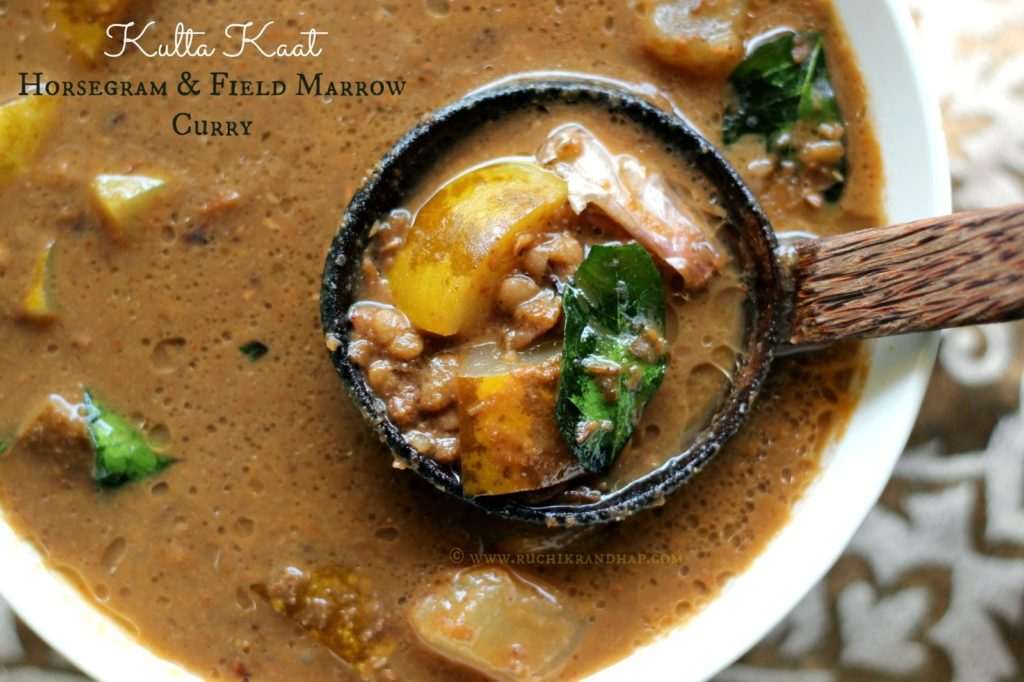
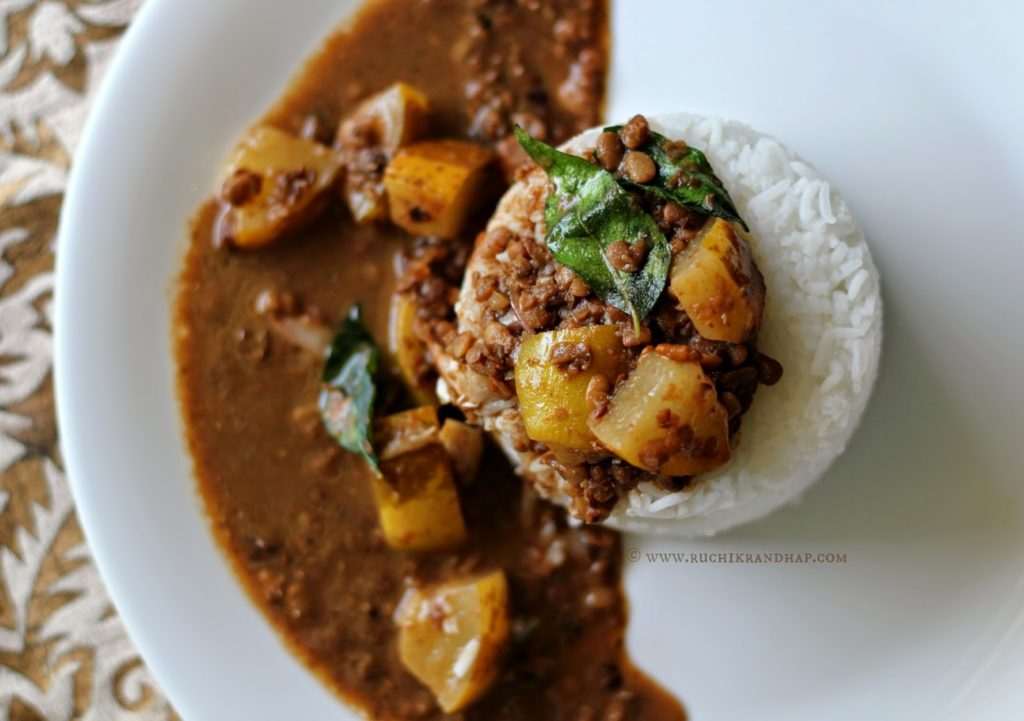

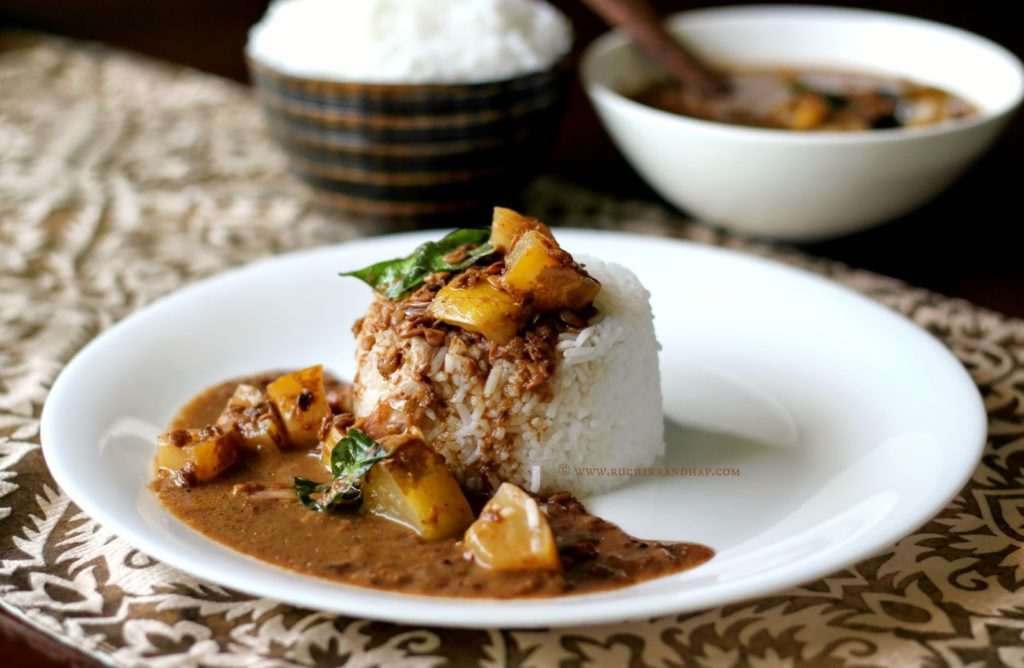
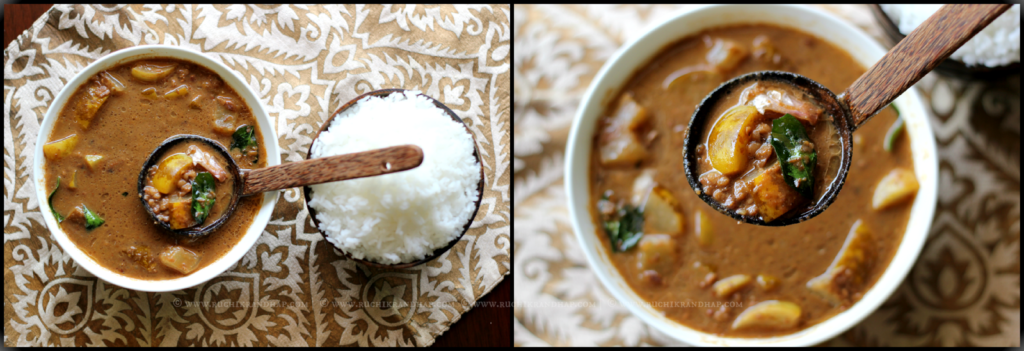
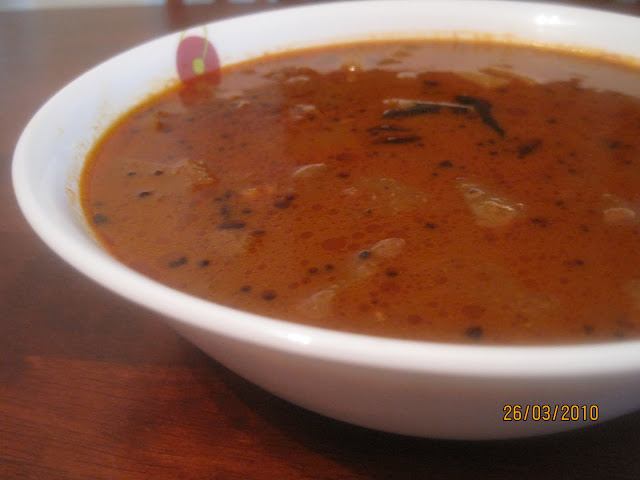
Can you please share recipes of Kultachi Chutney, kultaso saar, Kandi sukhe, Bondi sukhe, Kirl sukhe, bindi solanso saar and some typical traditional manglorean recipes 🙂
Hi Nisha,
I already have the kirl sukhe recipe on the blog, here's the link…
https://www.ruchikrandhap.com/2011/11/keerl-ani-moog-sukho-bamboo-shoots.html
the rest of the recipes will follow one by one, please do stay tuned!
I was delighted to find Nivole! Thanks for the Kirl and moog recipe 🙂 I'm adding Methya Pez to the request list.
@ Nisha: You are welcome 🙂 I will definitely post the Methi Pez recipe soon 🙂
Hi Ruchika, … hmm, er, ….. Shireen (;- >) lol. (giggle – )
Thank you for your lovely recipe and your delectable blog. I am a konkani and have visited Mangalore, about 6 or 7 times. When I saw 'field marrow', all I could think about was goat meat mutton ! Oh, its only an exotic melon. What a disappointment. I'm only kidding – I wish I had some marrow, of any kind, but alas, our cellar was bare – all I had was some half cup of Kuleeth. Enough for the wife and me, two of us. However, your recipe worked wonders and performed a miracle. We made do with a simple dinner and a glass of wine, and were satiated. Thank you.
I was fascinated by your mention of the 'roce' ceremony – although we are not Catholic and were married a long time ago, in the previous century …. I was still curious. I found out the bottom line and the details of the Roce ceremony on another website. The word roce is probably a corruption of the word 'Rassu' …. specifically coconut juice, which is poured and anointed and applied on the groom's face and various parts of the body and on those of his cohorts and best men – 'dedhes'. Nice custom. I wish I was 24 years old again. But, alas, I am now almost thinking of retiring and collecting my social security and medicare. So, life goes on.
Good luck in your blogging and I hope you attract lots and lots of readers, and I hope to come back soon and try another one of your wonderful recipes.
By the way, the Kultha saar, I made, was absolutely lip smacking and the 'little woman' has retired to bed, with a gorgeous smile on her lips…. I could not have wished for anything more.
Thank you, again, and God bless.!